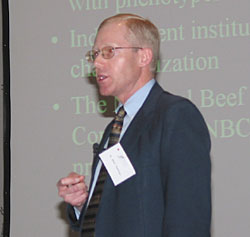
Cattlemen have come to believe DNA testing will make genetic selection simpler; whereas, it will actually make it more complicated, but more effective, said Mark Thallman of the U.S. Meat Animal Research Center (MARC) at Clay Center, Neb.
DNA testing is tool to fine-tune genetic evaluationsd
 Cattlemen have come to believe DNA testing will make genetic selection simpler; whereas, it will actually make it more complicated, but more effective, said Mark Thallman of the U.S. Meat Animal Research Center (MARC) at Clay Center, Neb. |
– by Shauna Rose Hermel